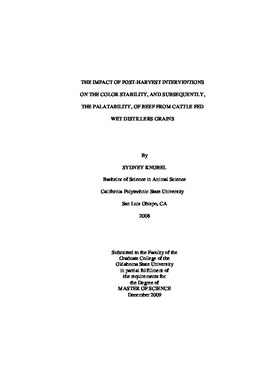| dc.description.abstract | Two hundred and forty heifers were fed at Oklahoma State University in Stillwater, OK, in one of two treatment groups: A dry rolled corn (CON) diet or a diet including 30% wet distillers grains plus solubles (WDGS). Chuck rolls (n = 60) and paired strip loins (n = 75 pairs; 38 CON, 37 WDGS) were collected from each treatment group and processed at 3 d and 14 d, respectively. After grinding, each chuck was separated into 8 polyvinyl chloride (PVC) film overwrapped packages and 8 high oxygen modified atmosphere packages (MAP), each containing approximately 0.45 kg of ground beef for color, sensory and Thiobarbituric Acid Reactive Substance (TBAR) analysis. After 14 d, one strip loin from each pair was injected with an enhancement solution. Steaks from each strip loin were fabricated and packaged, half PVC and half MAP, then evaluated for color, tenderness, and palatability. Color was evaluated subjectively using a trained color panel and objectively using a HunterLab Miniscan XE. An Instron Universal Testing Machine with a Warner-Bratzler head was used for evaluation of instrumental tenderness and a trained sensory panel was used to assess palatability along with TBAR analysis. Ground beef exhibited no significant differences in color between dietary treatments; however, sensory panelists did find MAP WDGS had less beefy flavor (P = 0.05) and more painty flavor (P = 0.01) intensities than the MAP CON ground beef. Cattle fed WDGS discolored more (P = 0.01) and had less bright steaks than cattle fed the CON when MAP and enhanced. Distillers fed, non-enhanced (NE) MAP steaks were redder and yellower than control steaks (P < 0.05) upon removal from simulated retail display. There were no other significant color differences between dietary treatments using any other combination of post-harvest interventions. In sensory panels, WDGS NE PVC products were juicier and more tender, initially, and contained less connective tissue (5.30 0.07, 5.49 0.05, and 5.86 0.43, respectively) than the steaks from CON carcasses (5.06 0.07, 5.37 0.05, and 5.73 0.43, respectively). While WDGS NE MAP steaks had showed more oxidation than CON NE MAP steaks upon removal from retail case, all TBAR values were well below the threshold of 2 mg malonaldehyde/kg. Essentially, MAP packaging, but not enhancing products, from cattle fed WDGS may be the best way to maintain a visually appealing appearance in the retail case, but at possible risk to product juiciness. | |
